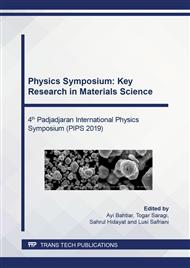p.288
p.297
p.303
p.310
p.315
p.320
p.329
p.338
p.345
Effect of Concentration and Nozzle-Collector Distance on the Morphology of Nanofibers
Abstract:
Electrospinning is a method for making nanofibers by utilizing an electric field produced by high voltage. Electrospinning process is influenced by several factors including the concentration of the solution, conductivity, viscosity, volatility, surface tension, electric field strength between the needle and the collector, feed / flow rate and environmental conditions which include temperature, humidity and air composition. Electrospinning parameters are used to optimize the size of the nanofiber, concentration of the solution and the distance of the nozzle to collector. In the process of electrospinning PVA solutions that are handled by high dc voltage gets an electrostatic force and electric field. The solution will elongate to form a Taylor cone, then a jet of polymer will undergo thinning and evaporation to form fibers in the collector. The results of morphological analysis using scanning electron microscopy (SEM) showed that the smallest nanofiber was obtained at a solution concentration of 5%, dc high voltage10 kV, and the distance of the nozzle to collector was 15 cms.
Info:
Periodical:
Pages:
315-319
Citation:
Online since:
August 2020
Authors:
Keywords:
Price:
Сopyright:
© 2020 Trans Tech Publications Ltd. All Rights Reserved
Share:
Citation:


